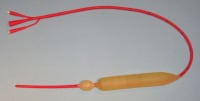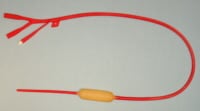Balloon tamponade of bleeding esophageal varices was described as early as the 1930s. A double-balloon tamponade system originally developed by Sengstaken and Blakemore in 1950 has undergone relatively few changes to the current day.[1, 2, 3] The 3 major components of a Sengstaken-Blakemore tube are a gastric balloon, an esophageal balloon, and a gastric suction port. The addition of an esophageal suction port to help prevent aspiration of esophageal contents resulted in what is called the Minnesota tube. Another nasogastric (NG) device with a single gastric balloon is most effective at terminating bleeding from gastric varices and is known as the Linton-Nachlas tube.[4] The advent of endoscopy has reduced the use of balloon tamponade, but the use of such devices can still be temporizing or lifesaving, despite their potential for serious complications.[5, 6, 7, 8]
See the images below.
 Sengstaken-Blakemore tube. Image courtesy of Richard Treger, MD.
Sengstaken-Blakemore tube. Image courtesy of Richard Treger, MD.  Linton-Nachlas tube. Image courtesy of Richard Treger, MD.
Linton-Nachlas tube. Image courtesy of Richard Treger, MD.
See the images below.
 Sengstaken-Blakemore tube. Image courtesy of Richard Treger, MD.
Sengstaken-Blakemore tube. Image courtesy of Richard Treger, MD.  Linton-Nachlas tube. Image courtesy of Richard Treger, MD.
Linton-Nachlas tube. Image courtesy of Richard Treger, MD.
ليست هناك تعليقات:
إرسال تعليق